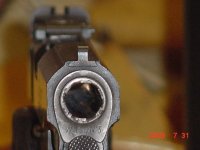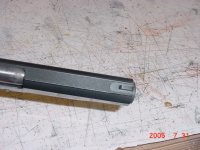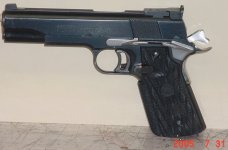Carpfisher,
I re-read your question and realized nobody had answered you on the advantages. There are two: safety and fit.
The fit comes about because the new trigger will either be oversize or very slightly undersize. If it is oversize you will have to scrap or file it to fit. If it is undersize, because it is aluminum it will be very easy to upset the 4 corners of the trigger body, then scrape or file them to fit.
The more important item is the safety issue. It is the "bounce" Dave referred to. When you let the slide go forward to chamber a round, it accelerates in a graduated fashion as the recoil spring pushes it forward. That same spring also works with equal and opposite force against the frame rearward, imparting an opposite direction momentum to the rest of the gun, including the trigger. When the gun goes into battery, the slide comes to a fairly abrupt stop against the assembly pin. This means the slide’s forward momentum is transferred to the frame via the assembly pin, neutralizing the frame’s rearward momentum. That is Newton's law of conservation of momentum—were it not so, the 1911 would be some kind of free energy machine.
The problem with all this is nothing tells the trigger the momentum is being neutralized. The frame may cease rearward movement, or even gain some from the spring of the hand behind it, but inertia keeps the trigger going toward the rear. If the middle leaf of the flat spring doesn’t apply enough force to stop the trigger and disconnector, the disconnector is pushed into the sear by this momentum. At this point, the only thing preventing the hammer from dropping and firing the round is opposing pressure from the left leaf of the flat spring on the sear feet, the engagement release force at the sear and hammer hooks from mainspring pressure, and the inertial mass of these objects. If the trigger has enough inertia, it will overcome this opposition and drop the hammer and discharge the weapon when you close the slide.
You can test your gun for this problem. Unload the gun and tear it down far enough to get the hammer out. Use a toothpick to stuff the half-cock notch with paper towel. This is so that, should your gun drop into half-cock during this test, it doesn’t bang up your finely tuned sear nose. Put it back together. Don't load it. Pull the slide back and push the slide stop up to hold it in place. Point it muzzle up (worst case, since gravity is now acting on the trigger mass as well). Hold the grip panels lightly between the thumb and fingers of your right hand (again, worst case: limp grip). Now use the thumb of your left hand to depress the slide stop and let the slide slam into battery. If the hammer drops, you have the problem.
The best solution includes reducing the mass of the trigger so it has less rearward momentum imparted by its travel with the frame as the slide accelerates forward. This is the value of aluminum over steel in this application. The other elements are not to have cut your hammer hooks too low or with too shallow an angle, nor to have taken too much pressure off your flat spring leaves, nor have too weak a mainspring, nor have a sub-tangent angle on the sear nose. In other words, don't go for too light a trigger or you will be sensitive to this problem even with an aluminum trigger.
I went so far as to try a super light carbon fiber composite trigger on my school gun. But I didn't like the feel (not as smoothly lubed feeling as metal) and I didn't trust the stability of the overtravel screw threaded into that soft material.
Nick





